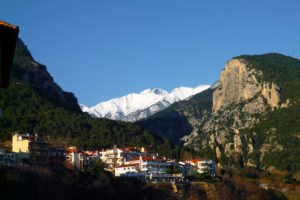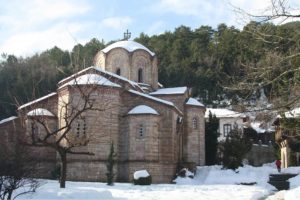Mythology-History
The shape of Mount Olympus, the polymorphous and changeable beauty of its nature, the mist which covers its peaks, the low cloud that often bring storms – these-have filled people with awe and admiration from ancient times. Recent archaeological finds go back to the Iron Age and prehistoric people chose to live in the foothills of this glorious mountain. Inspired by its mystery, the ancient Greeks created the legends that gave birth to the Twelve Greek gods.
Thus Zeus and Hera, their siblings Hestia, Demeter, Poseidon and their seven children Athena, Apollo, Artemis, Hermes, Ares, Aphrodite and Hephaestus, were the famous 12 gods who lived on Mount Olympus.
According to Homer, the twelve gods lived in ravines in “the mysterious folds of Olympus”, where they had their palaces. In The Iliad, Mount Olympus is described as “magnificent”, “long”, “glorious” “glistering” and “full of trees”.
Pantheon (today’s Mytikas-the highest peak of Mount Olympus) was their meeting place. Their tempestuous arguments were apparently heard by the “god of gods”, Zeus, sitting on his imposing throne (today’s Stefani). From there he unleashed his thunderbolts, displaying “his godly wrath”.
Τhe famous 12 gods where honored particularly in the city of Zeus (Dias), ancient Dion, the sacred city of the Macedonians dedicated to Zeus, at the foothills of the mountain, five kilometers from the sea. It probably flourished between the 5th century B.C. and the 5th century A.D. Ongoing archaeological excavations, which started in 1928, revealed finds from the Macedonian, Greek and Roman Eras. These are exhibited in the museum of Dion.
According to tradition -and further supported by more recent research-, ceremonies and rituals were also carried out on the peaks of Mount Olympus. This has been confirmed by findings (marble columns with inscriptions, ceramics, coins, remnants of offerings) which connect the mountain with the worship of the gods. Piblia and Livithra are two more ancient cities near Olympus and are associated with the legend of Orpheus and the Orphic secret ceremonies.
The history of Mount Olympus continued being turbulent under the Turkish occupation. The mountain was a hiding place for the famous “Armatol” (brave Greek resistance fighters), who fought against the “yoke of the tyrant”, the Ottoman Empire. During the German invasion in 1941, the Greek army, along with Australian and New Zealand units, fought important battles. Later in the war, Greek Resistance found a secure place of refuge there.











